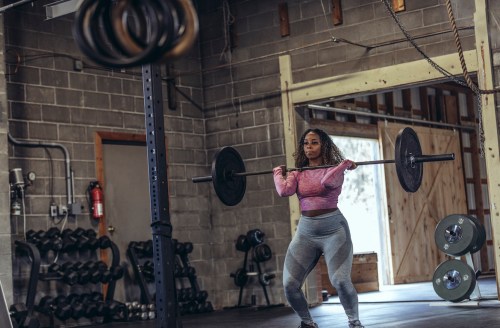Strength training is great for keeping your muscles and bones strong, and it’ll help improve heart health, joint and bone health, and overall longevity and wellness. So it’s smart to include weight-training exercises for lower and upper body a few times each week to stay on track with your goals.
Experts in This Article
professional trainer and performance coach for the Villanova University men’s basketball program
When you do, keep in mind that the standing military press is one of the best upper-body exercises you can do to improve strength in your arms, shoulders, back, and chest, while still also impacting other areas of the body (think: the core, legs, glutes, and hips) to provide a full-body workout.
If this exercise is new to you, this is the first thing to know: “The standing military press is a vertical pressing exercise performed with a barbell, and it’s a great compound (or multi joint) exercise for upper body strength and muscular development,” says John Shackleton, CSCS. And once you’ve mastered proper form, you’ll see major benefits by means of upper body strength and mobility. But that’s not all.
Benefits of a standing military press
The standing military press specifically targets and strengthens all the muscles around the shoulder complex. “The deltoids are the main muscles working as the bar is being pressed overhead, and the middle deltoids are the primary movers, while the anterior and posterior deltoids assist and stabilize the shoulder joint throughout movement,” Shackleton says.
The standing military press is not only a hardcore upper-body strength exercise, but also a great move for the lower body too. “Since you are standing upright with your feet in contact with the ground it makes for a great functional, total-body exercise,” Shackleton adds. “As you press the weight overhead, all the muscles surrounding your core, hips, knees, and ankles must work together to provide stability.” And so they’re reaping the benefits of growing stronger, too.
Proper form for the standing military press
Technique is key, as it prevents injury and increases the effectiveness of the move. Find a barbell racked in a squat rack at shoulder height. Step up to the bar and have it meet your shoulders. Take a grip shoulder width apart and roll your elbows directly under the bar so they are in line with your wrists.
Lift the bar out of the rack and rest it on your shoulders, then take two steps back. Make sure your feet are directly under your hips. Knees should be fully extended (but not locked out) with quads actively engaged. Hips should be pushed forward so they are under your shoulders. Keep the glute muscles actively engaged by squeezing them.
Keep your ribcage down rather than flared to avoid stress in the low back, and keep your core locked in and tight by drawing your belly button toward your spine.
How to do a standing military press
Here’s how to do the move with the right form in mind and for the greatest benefits possible.
- 1.Begin by taking a deep breath in through the nose and push the bar straight up overhead as you exhale. “As it passes your forehead, push your head through your arms for leverage, and at the final point the bar should be directly overhead with your biceps directly to the sides of your ears,” Shackleton says.
- 2.Stabilize the bar overhead for 1–2 seconds.
- 3.Slowly bring the bar back down to the starting position with control, taking 3–4 seconds, so that you work your muscles in both directions. “This will protect the shoulder joint and let the shoulder stabilizers do their job,” Shackleton says.
- 4.You can then repeat this process for as many sets and reps you like, according to your fitness program.
A pro tip? Make sure the hands are right outside the shoulders. “This is the optimal hand-width placement for shoulder health and performance since the shoulder joint is packed in tight,” Shackleton says.
Also, Shackleton says it’s important to make sure the elbows are under the bar before you begin to push. “You want the force to be directed right up into the bar and if the elbows are flared out to the sides, it places unnecessary stress on the shoulders, and you will not be able to push as much weight,” he explains.
Avoid standing military presses if you experience any of the following…
“The standing military press would be contraindicated for anybody with a pre-existing shoulder or spinal injury, and if you lack shoulder mobility, you will want to make sure you have a fully functional shoulder before pressing overhead,” Shackleton says.
Oh hi! You look like someone who loves free workouts, discounts for cult-fave wellness brands, and exclusive Well+Good content. Sign up for Well+, our online community of wellness insiders, and unlock your rewards instantly.
Sign Up for Our Daily Newsletter
Get all the latest in wellness, trends, food, fitness, beauty, and more delivered right to your inbox.
Got it, you've been added to our email list.











